Trying to figure out how to back up the WooCommerce database?
WooCommerce is a popular full-service ecommerce plugin that makes it easy for anyone to create a store powered by WordPress.
If you used WooCommerce to build your store, taking regular backups is essential to ensure you never lose important data such as new orders, customer information, stock status, and so on.
But while backups are important, you might not be sure how to get started and how often to back up your store, especially if you have a busy store with lots of incoming orders.
This post will teach you everything you need to know about WooCommerce backups, including best practices and how to start backing up your store.
Check Out Our Video Guide on How to Backup the WooCommerce Database
Why Is It Important to Backup the WooCommerce Database?
With an established WooCommerce store, your store’s files might not change that much day-to-day. If you’ve already chosen a WooCommerce theme, added your product photos, and installed all the necessary plugins, your store’s files will remain the same for the most part.
In contrast, your WooCommerce store’s database is constantly changing. Every time shoppers place orders, register accounts, leave reviews, and so on, all of that information is stored in your store’s database. The same is also true for when you change the status of an order, edit a product’s stock status, and make any other changes to your store’s data on the backend.
If you lose the information in your store’s database, you could have missing orders, lost customer information, deleted reviews, inaccurate product details, and other major issues. Losing this data can lead to missing revenue, a loss of trust with your customers, and general damage to your store’s functioning.
Learning how to back up the WooCommerce database and implementing a strong backup policy can help you avoid those issues.
If your live store experiences problems, that’s never a good thing. But having an effective WooCommerce backup policy ensures that those problems are an inconvenience rather than a disaster.
How Often Should You Backup the WooCommerce Database?
How often you should back up the WooCommerce database depends on how active your store is.
The basic question you should be asking yourself is this:
“If I lost all the data from the last X minutes/hours/days, how big of a problem would that be?”
If your store only has a few orders per week and you don’t edit/update product details very often, you might only need to back up once per day.
On the other hand, if your store gets dozens of orders per day, losing even just one day’s worth of data could be a big deal. In that scenario, you would want to back up more frequently.
In terms of more frequent backups, you have two options:
First, you can increase the backup frequency. For example, maybe you back up your store every hour instead of once per day. That way, even the worst-case scenario would only have you losing one hour’s worth of data.
However, even losing an hour’s worth of data could be a big problem for some bustling stores. In that situation, you might want to go with the second option — real-time incremental backups.
With real-time incremental backups, your site will automatically back up changes as they happen. For example, when a new order comes in, that database change is instantly backed up.
To avoid performance issues, these tools will use an incremental approach. This means that the tool will only back up the new changes — it won’t run a full backup of your store for every change. So when that new order comes in, it will only back up the new database information from that order, rather than taking a full backup of your database (because it’s already backed up the other information).
How to Backup Your WooCommerce Store With Kinsta
If you host your WooCommerce store with Kinsta, Kinsta’s dedicated backup tool makes it easy to back up your store’s database and files.
First off, Kinsta will automatically back up your complete store every day by default (files and database). You also have the option to increase the frequency of these automatic backups, which we’ll discuss in a second.
You can access all of these backups from the Backups tab of your store’s dashboard in MyKinsta.
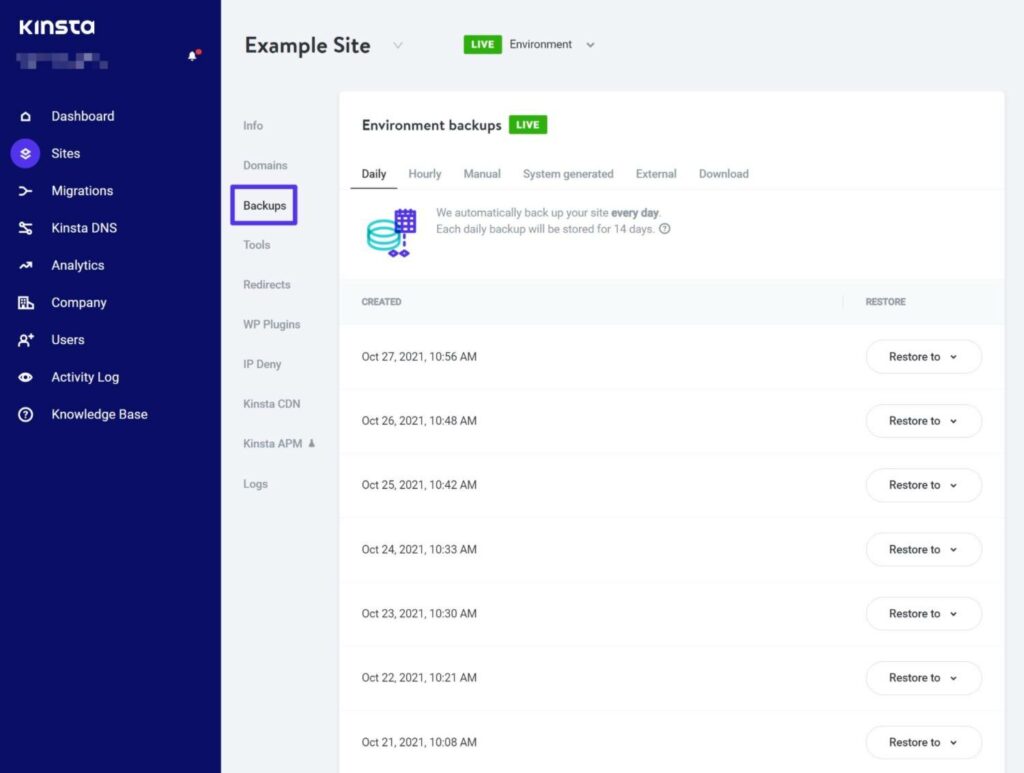
If you’re about to make a change to your store, you can also have Kinsta take a manual backup of your store with just a few clicks. Just head to the Manual tab and click the Back up now button:
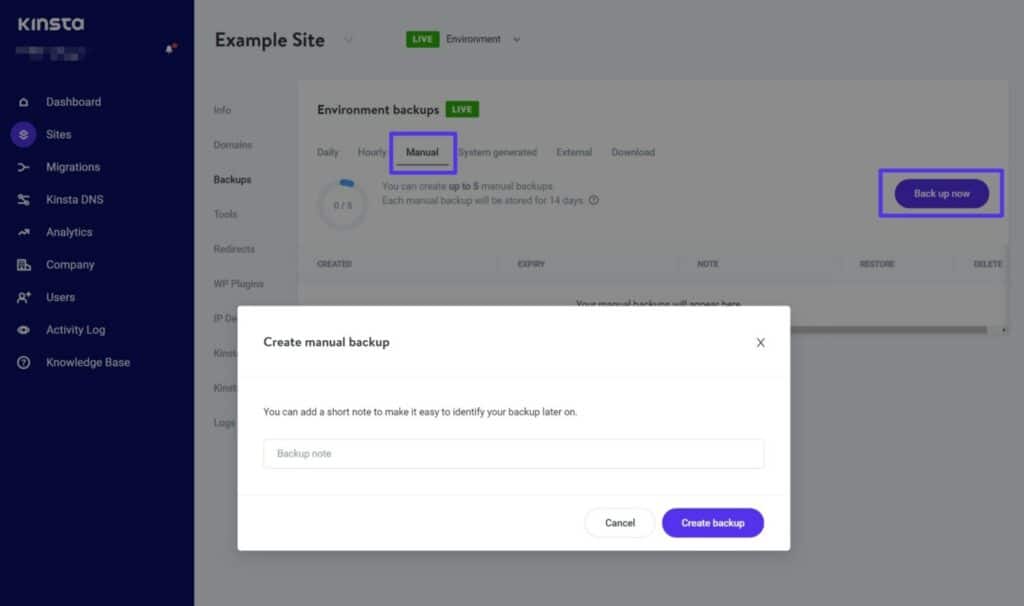
How to Increase the Frequency of Kinsta Automatic Backups
By default, Kinsta automatically backs up your store every day and stores those backups for 14-30 days (depending on your plan).
If your store needs more frequent backups, you can pay a little extra to back up more frequently on the following schedules:
- Every six hours – $50 per month per site.
- Every hour – $100 per month per site.
To upgrade your backup frequency, go to the Hourly tab in the Kinsta backup tool.
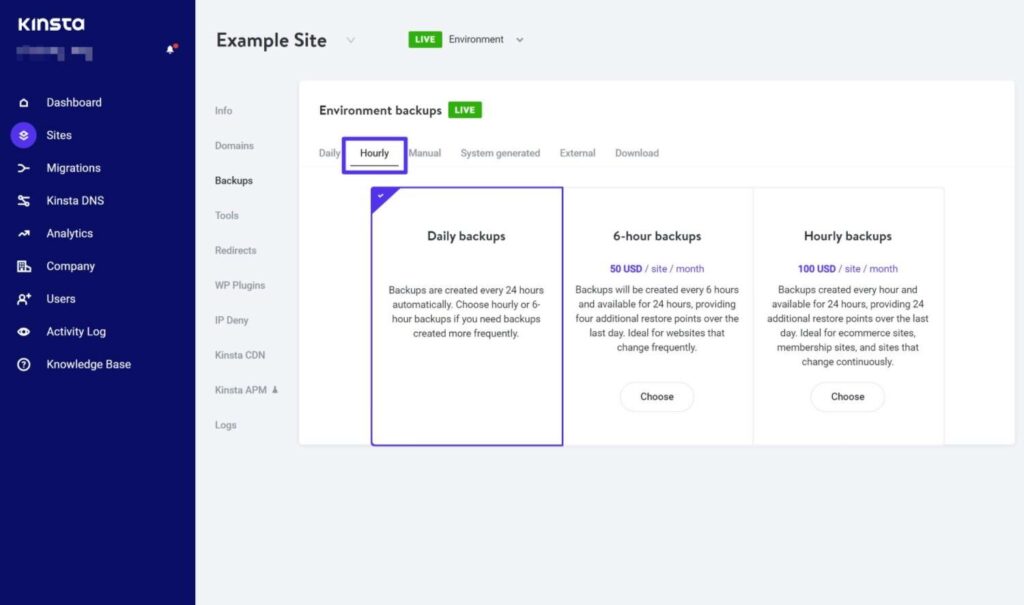
How To Backup the WooCommerce Database With Plugins
If you’re not hosting with Kinsta or if your store has unique backup needs, you might want to go with a WooCommerce backup plugin.
One advantage of using a dedicated backup plugin is accessing real-time incremental backups. Again, this means that your backup solution will back up new changes as soon as they happen.
However, the caveat here is that all the plugins that offer real-time incremental backups charge for this feature. Depending on the plugin, you’ll pay anywhere from $49 per year to $480 per year.
Here are your best options.
Jetpack Backup

Jetpack Backup is a popular backup plugin/service from Automattic, the same company behind the WooCommerce plugin. This functionality used to be part of the comprehensive Jetpack plugin, but Automattic recently spun it off as its own separate Jetpack Backup plugin in October 2021.
Jetpack Backup will automatically back up your site to Automattic’s servers using an incremental backup approach. Depending on your plan, you’ll either get daily backups or real-time backups.
It also offers unlimited backup storage, and you can quickly restore your store to any backup point with just a few clicks.
Jetpack Backup’s prices depend on your backup frequency:
- Daily incremental backups – $96 per year.
- Real-time incremental backups – $480 per year.
You can also get a 50% discount on your first year, so you’ll only need to pay the full retail price from the second year.
BlogVault
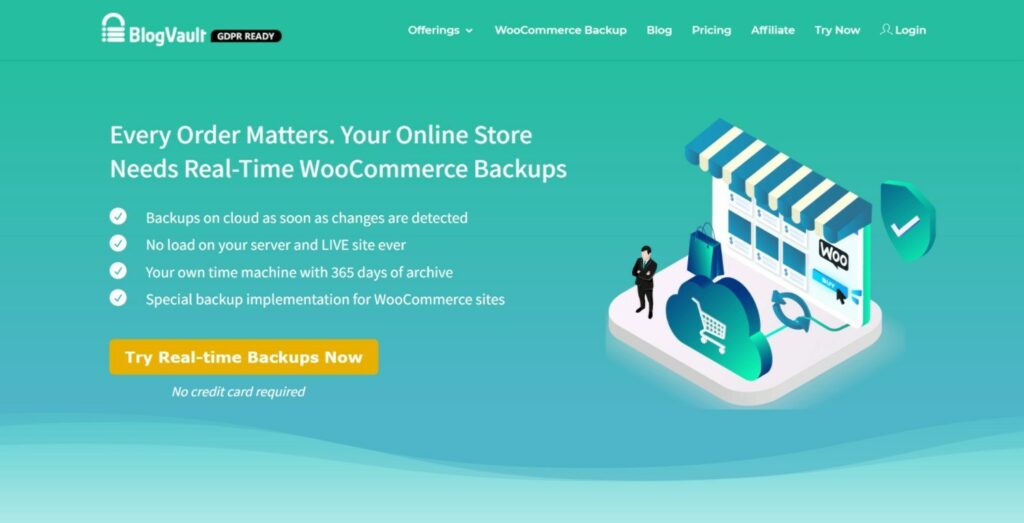
BlogVault is a premium WordPress backup plugin that automatically backs up your site and stores the backups in BlogVault’s cloud.
Overall, it’s quite similar in functionality to the Jetpack Backup plugin above.
The entry-level plan will automatically back up your store daily and store those backups for 90 days. However, most WooCommerce stores will probably want the Advanced plan, which offers real-time incremental backups and 365 days of storage.
In addition to backing up your site, BlogVault also makes it easy to restore your backups to your live site or a staging server.
The entry-level Basic plan costs $89 per year, but the WooCommerce-focused Advanced plan will cost you $249 per year.
WP Time Capsule

WP Time Capsule offers a slightly different approach to the previous two plugins. Rather than creating its own cloud storage service for your backups, WP Time Capsule has you send your backups to your account at your preferred cloud storage provider.
Currently, WP Time Capsule supports the following options:
- Amazon S3
- Google Drive
- Dropbox
- Backblaze B2
- Wasabi
This adds a little complexity to the setup process, but it also means that you’re in full control of your data. WP Time Capsule is also cheaper than the previous two plugins because it’s only selling a plugin (rather than bundling in a storage service).
WP Time Capsule offers real-time incremental backups, so it will automatically back up your database every time there’s a change. It also offers incremental restores, so you can quickly restore your store to a specific change.
You can also benefit from a 365-day restore window if you use Amazon S3, Wasabi, or Backblaze B2 as your storage source. However, the other cloud services only support 30-day restore windows.
For use on up to two sites, WP Time Capsule costs just $49 for a one-year license or $149 for lifetime support and updates.
However, remember that you’ll also need to pay for your cloud storage. Usually, this is quite affordable, though. For example, Amazon S3 Standard costs just $0.023 per GB per month. That’s 2.3 cents per GB — so 43 GB of backups would cost just $1 per month.
UpdraftPlus

UpdraftPlus is unique on this list in two ways – one positive and one negative:
- Positive – It has a fully functional free version, which none of the other plugins offer.
- Negative – It doesn’t support real-time backups. It supports incremental backups, but you can’t do them in real-time.
While UpdraftPlus doesn’t support real-time backups, it does let you set up your own custom automatic backup schedules. You have complete control over the schedule — for more advanced users, you can even trigger backups based on a server cron job or WP-CLI.
The exceptional detail here is that UpdraftPlus lets you use different backup schedules for other parts of your site. For example, you could back up the WooCommerce database every hour but only back up your files once per day. Or – you could go even further apart and back up your database every 30 minutes and your files every three days – it’s totally up to you.
To store your backups, UpdraftPlus can automatically send the backup files to a range of cloud storage providers, including the following:
- Amazon S3
- Google Cloud Storage
- Any S3-compatible provider including DigitalOcean Spaces, Cloudian, Eucalyptus, and more
- Google Drive
- Dropbox
- Any FTP server
- Rackspace Cloud
Or, the developers also offer their own paid storage service called UpdraftVault.
UpdraftPlus also makes it easy to restore all or some of your site. For example, you could restore your WooCommerce database backup without changing any files.
The free version of the plugin should work for many stores, especially if you feel comfortable using cron jobs or WP-CLI to schedule backups.
The premium version costs $70 and gives you incremental backups, flexible in-dashboard backup scheduling, more off-site storage options, more database backup options, and other valuable features.
How to Restore Your WooCommerce Store From a Backup
Having a recent backup of your store is only part of the puzzle — you also need to be able to restore that backup if disaster strikes your live store.
First off, we always recommend restoring backups to a staging site. That way, you can fully test your backup before making it live.
If you’re using Kinsta’s backup tool, you can restore directly to your staging site.
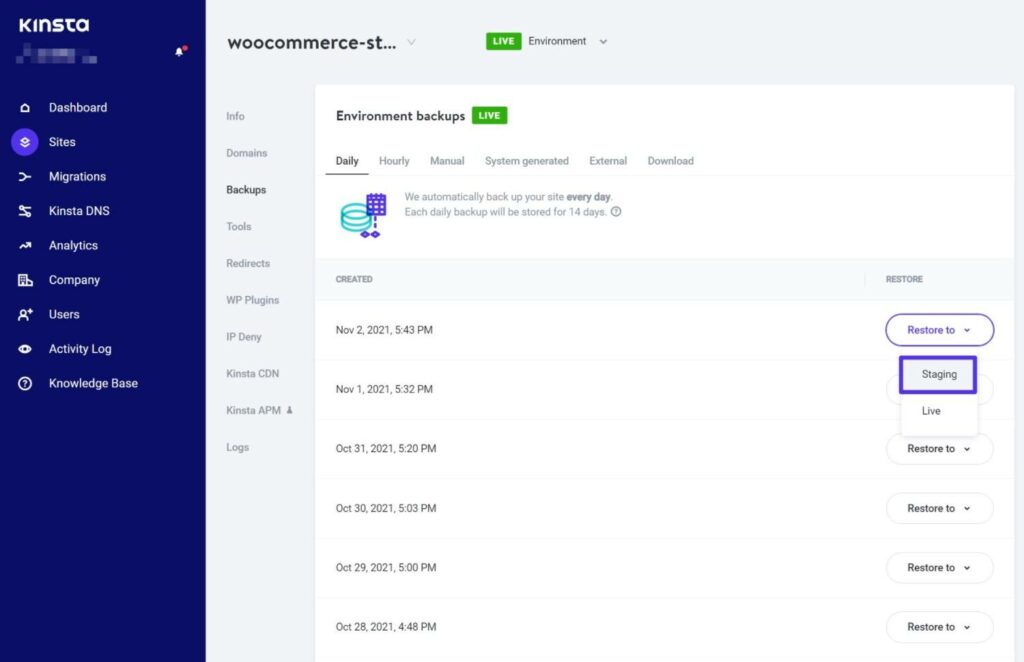
Once you’ve tested everything on your staging site, you can make the restored version of your site live. With Kinsta’s selective push staging option, you can choose between only applying the database changes to your live store or pushing both the files and database live.
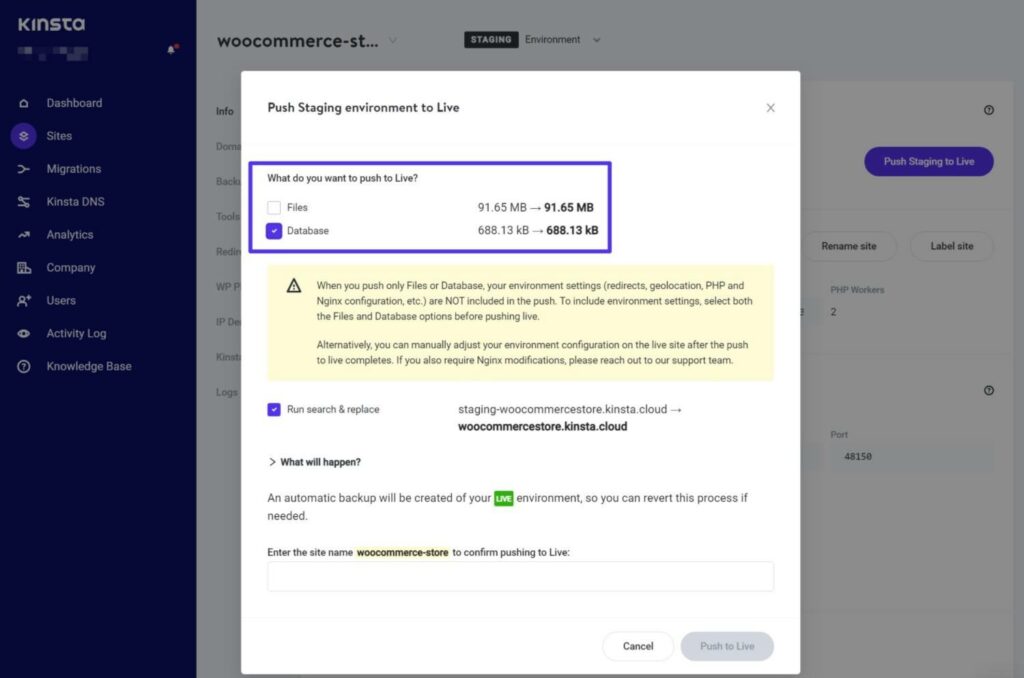
If you’re using one of the WooCommerce backup plugins above, all of them offer easy one-click restore processes.
They also give you the option to restore your store to a staging site, though some make it easier than others. We recommend consulting the plugins’ support documentation for help.
If needed, you can also manually migrate your store to make it live, though you should try to avoid the manual route if possible.
WooCommerce Backup Best Practices
We’ve covered some of these tips above, but let’s finish out with a quick recap of some general WooCommerce backup best practices.
Backup As Often as Needed
We discussed backup frequency earlier in this post, but it’s worth quickly revisiting as it’s essential to keeping your store’s data safe.
In general, your store’s ideal backup policy depends on how active it is.
Remember, this is an important question to answer:
“If I lost all the data from the last X minutes/hours/days, how big of a problem would that be?”
For some stores, that answer might be one day, in which case daily backups might be fine. For other stores, that answer could be five minutes, in which case you probably want a real-time incremental backup solution.
Store Backups Offsite
You should never exclusively store your backups on the same server as your WooCommerce store, as that creates a single point of failure. If something happens to your store, you lose both your live store and your backups.
If you’re using Kinsta backups, you don’t need to worry about this because we handle safely storing backups for you.
If you want some extra flexibility, you can also purchase the external backups add-on to have Kinsta send your backups to your own Amazon S3 or Google Cloud Storage account.
On the other hand, if you’re using a WooCommerce backup plugin, you’ll need to ensure that you’ve configured the plugin to store backups off-site. Plugins such as Jetpack Backup and BlogVault handle this automatically, while a plugin like UpdraftPlus requires you to set up off-site storage specifically.
You can also consider downloading backup copies to your local computer, which helps you follow the 3-2-1 backup strategy — store three total copies of your data, two of which are local on different mediums, and at least one which is off-site.
At Kinsta, you can download a backup once per week by going to the Download tab of the backup tool.
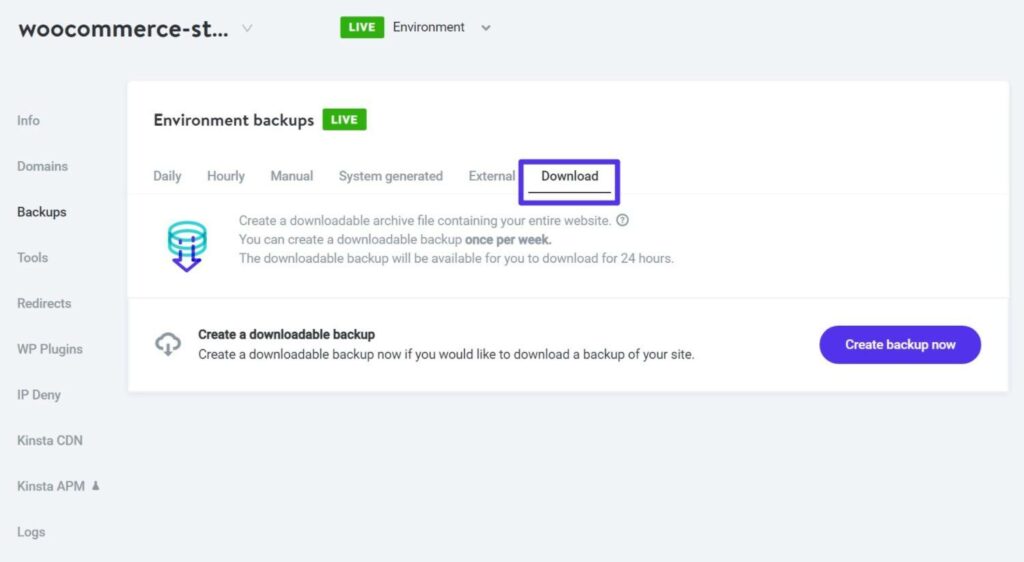
Restore Backups to a Staging Site
Unless it’s completely unavoidable, you never want to restore a backup directly to your live website.
While a backup should be a perfect representation of your store as it existed at that backup point, it’s crucial to test the restored version of your site to make sure that there aren’t any issues.
If you restore to a staging site, you’ll be able to test everything in a safe environment thoroughly. Once you verify that your store is functioning properly, you can push the staging environment live.
If you host with Kinsta, you can also take advantage of Kinsta’s selective push staging feature to push your staging database live without changing any files on your live site. This can be especially handy for WooCommerce stores because most of your store’s changes will be in the database rather than files.
Periodically Test Your Backups
Backups are only useful if:
- They work regularly.
- You know how to restore them if something goes wrong with your live site.
For those reasons, it’s important to periodically test your backups to make sure you understand the process and can restore a working copy of your site from your backup files.
To test things in a safe environment, you can practice restoring your backup to a staging site or using a local development tool such as DevKinsta.
Summary
Learning how to back up the WooCommerce database is essential to secure your store’s data.
If you’re hosting at Kinsta, Kinsta will automatically back up your store every day. If you need more frequent backups, you can upgrade that automatic frequency to as often as once per hour.
For even more frequent backups, you can consider a real-time incremental backup plugin to back up changes as they happen.
Once you have your backups, you can quickly restore your store to a staging site. Then, with Kinsta’s selective staging push feature, you can choose whether to restore the entire site or just the database changes on your live store.


